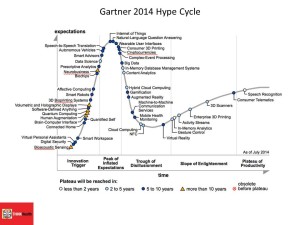 Remote health monitoring is in the Trough of Disillusionment. Wearables are at the Peak of Inflated Expectations, with Big Data leapfrogging wearables from the 2013 forecast — both descending toward the Disillusionment Trough. Mobile (remote) health monitoring, however, has fallen into that Trough of Disillusionment as RHM has been undergoing reality checks in the health care system especially for monitoring and patient self-management of heart disease (most notably heart failure) and diabetes.
Remote health monitoring is in the Trough of Disillusionment. Wearables are at the Peak of Inflated Expectations, with Big Data leapfrogging wearables from the 2013 forecast — both descending toward the Disillusionment Trough. Mobile (remote) health monitoring, however, has fallen into that Trough of Disillusionment as RHM has been undergoing reality checks in the health care system especially for monitoring and patient self-management of heart disease (most notably heart failure) and diabetes.
Welcome to the 2014 edition of the Gartner Hype Cycle, one of my most-trusted data sources for doing health industry forecasts in my advisory work. Compared with last year’s edition, these three health-related innovations are all moving down from the apex of that Peak of Inflated Expectations as each technology segment is getting tested and tried in health care — a tough market and slow-moving environment for innovating when technologies don’t get directly reimbursed.
The Connected Home is new to the Hype Cycle curve, in 2014 seen as an Innovation Trigger toward the start of the curve. As I discussed here on Health Populi, early marketing and PR efforts for Connected Homes are focused on home security and energy use, with nil focus on health applications based on my reading of the most recent meeting of the Consumer Electronics Association in New York City in July 2014.
Gartner’s forecast for mobile health monitoring, the most mature of the technologies related to health on the Cycle, is hitting a plateau in 5 to 10 years.
Health Populi’s Hot Points: While The Connected Home is still a new-new thing on the 2014 Hype Cycle, my own forecast of the larger health ecosystem recognizes the move of health care payment from volume to value — that is, the migration of compensating health providers (hospitals and physicians) on the basis of condition management, population health, and bundling payments for an episode of care. Accountable care (writ with a large “A” for Medicare programs and small-case “a” for value-based payment in commercial pay settings) will also motivate more care in the person’s home, and more incentive to keep people well at home and at the workplace. This will provide the rationale for early adoption of Connected Home programs that think big-picture in terms of co-creating health where people “live, work, play, pray and learn.”




 I'm in amazing company here with other #digitalhealth innovators, thinkers and doers. Thank you to Cristian Cortez Fernandez and Zallud for this recognition; I'm grateful.
I'm in amazing company here with other #digitalhealth innovators, thinkers and doers. Thank you to Cristian Cortez Fernandez and Zallud for this recognition; I'm grateful. Jane was named as a member of the AHIP 2024 Advisory Board, joining some valued colleagues to prepare for the challenges and opportunities facing health plans, systems, and other industry stakeholders.
Jane was named as a member of the AHIP 2024 Advisory Board, joining some valued colleagues to prepare for the challenges and opportunities facing health plans, systems, and other industry stakeholders.  Join Jane at AHIP's annual meeting in Las Vegas: I'll be speaking, moderating a panel, and providing thought leadership on health consumers and bolstering equity, empowerment, and self-care.
Join Jane at AHIP's annual meeting in Las Vegas: I'll be speaking, moderating a panel, and providing thought leadership on health consumers and bolstering equity, empowerment, and self-care.